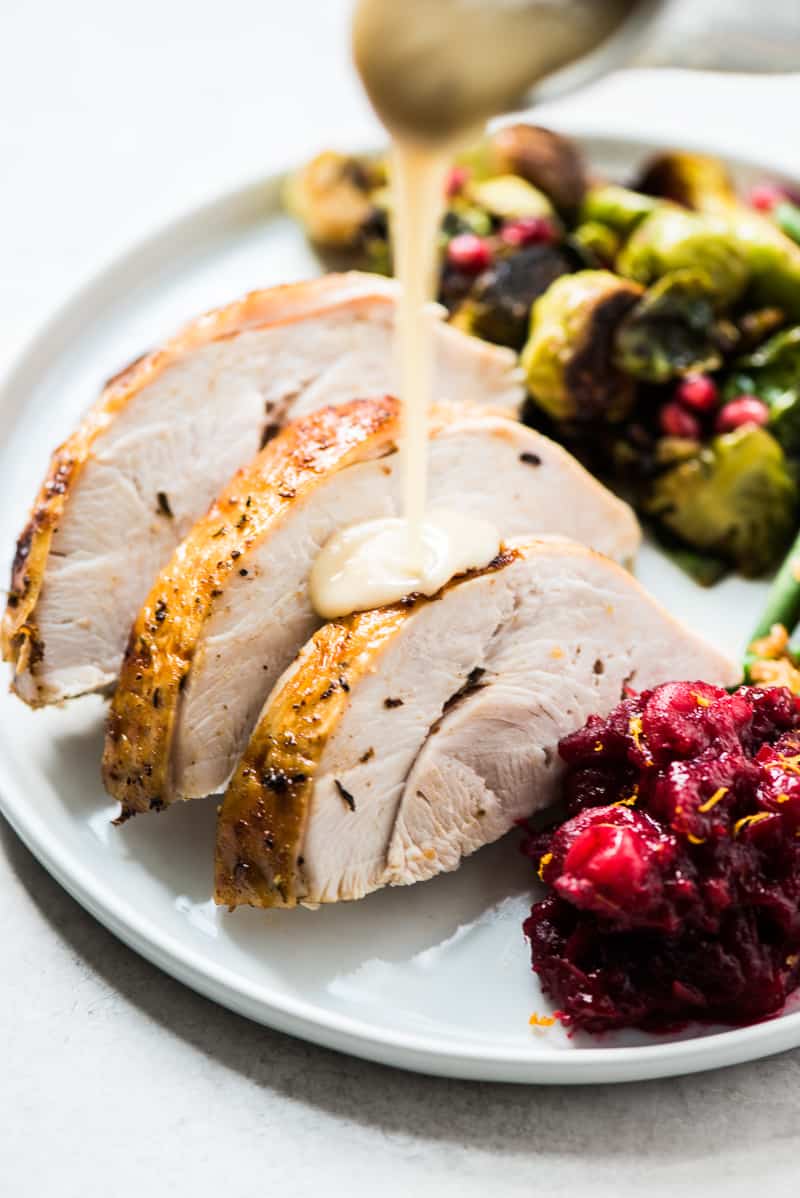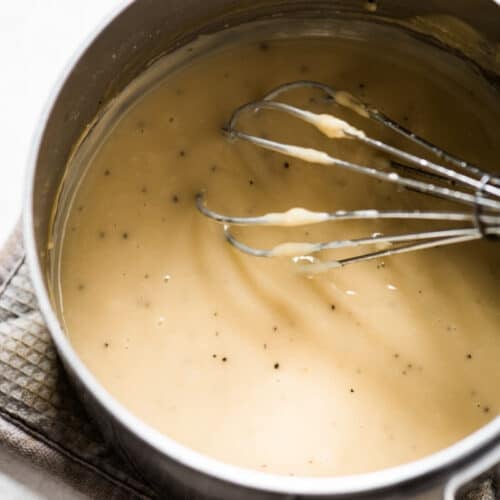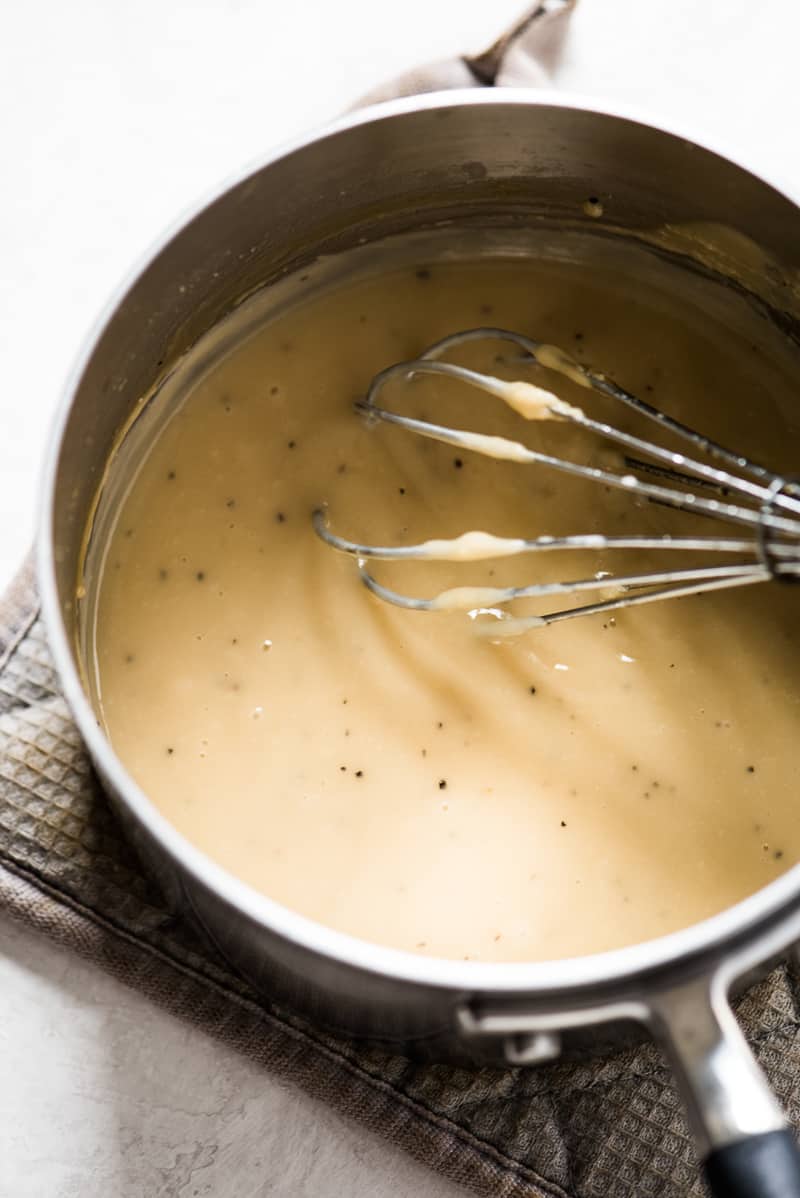Learn how to make turkey gravy from drippings the easy way. Don’t let all the seasonings and juicy pan drippings from your turkey go to waste!.
Don’t let all the seasonings and juicy pan drippings from your turkey go to waste. The best turkey gravy recipe ever can be made with all those delicious brown bits from the bottom of your roasting pan!
I don’t know about you, but you can bet that I enjoy drizzling good gravy—not just on the meat—all over my plate whenever it’s available at the dinner table. When there’s gravy everywhere—on mashed potatoes, green beans, Brussels sprouts, and more—you know it’s good.
One of the simplest and best ways to create a rich, flavorful gravy that brings out the flavor of the Thanksgiving turkey you worked so hard to prepare is to use the drippings from the turkey. The best part is that you can prepare it while your turkey is cooling down and resting, ready for carving.
The drippings from a roasted turkey are a culinary goldmine, brimming with rich flavor and versatility Whether you’re a seasoned chef or a kitchen novice, learning how to use turkey drippings can elevate your dishes to new heights
What are Turkey Drippings?
Turkey drippings are the liquid that accumulates in the bottom of the roasting pan after cooking a turkey. This flavorful liquid is a combination of melted fat, meat juices, and seasonings, making it an invaluable ingredient for a variety of culinary creations.
Is the Oily Liquid Worth Keeping?
Absolutely! While some may view the oily layer with skepticism, it’s precisely this fat that adds depth and richness to your dishes. Don’t be afraid to embrace the oil – it’s a key component of the drippings’ magic.
How to Use Turkey Drippings:
-
Gravy: This is the most classic and beloved use for turkey drippings. Simply whisk the drippings with flour to create a roux, then gradually add broth or stock to create a smooth, flavorful gravy.
-
Roasted Vegetables: Drizzle your roasted vegetables with turkey drippings before popping them in the oven. The fat will caramelize the vegetables, adding a delicious depth of flavor.
-
Soup Base: Turkey drippings make an excellent base for a hearty and flavorful soup. Simply add vegetables, broth, and your favorite seasonings to create a comforting and satisfying meal.
-
Fried Bread: This is a British tradition that’s perfect for using up leftover turkey drippings. Slice some bread, heat the drippings in a pan, and fry the bread until golden brown. It’s a simple yet incredibly delicious way to enjoy the leftover goodness.
-
Stuffing: Add a spoonful or two of turkey drippings to your stuffing recipe for an extra burst of flavor. The fat will help to keep the stuffing moist and flavorful.
-
Mashed Potatoes: For extra-rich and creamy mashed potatoes, stir in a few tablespoons of turkey drippings along with the butter and milk.
-
Pan Sauce: Deglaze your roasting pan with a little wine or broth, scraping up the browned bits, and then whisk in the turkey drippings to create a delectable pan sauce for your turkey or other dishes.
Tips for Using Turkey Drippings:
- Strain the drippings: Use a fine-mesh strainer to remove any bits of meat or skin before using the drippings.
- Skim the fat: If you prefer a less oily gravy or sauce, you can skim off some of the fat before using the drippings.
- Store the drippings: Turkey drippings can be stored in an airtight container in the refrigerator for up to 3 days or frozen for longer storage.
Turkey drippings are a culinary treasure that should not be discarded. By learning how to use them effectively, you can add incredible flavor and richness to your dishes, transforming ordinary meals into culinary masterpieces. So, the next time you roast a turkey, don’t throw away the drippings – embrace their potential and unlock a world of delicious possibilities!
What to Serve with Turkey Gravy
If you’re making this gravy for an upcoming Thanksgiving or Christmas celebration, here are a few serving suggestions:

- Medium saucepan. Perfect for making the gravy. This saucepan lessens the possibility of burning by dispersing heat evenly.
- Strainer. helpful for creating a smoother gravy by straining out any bits from the drippings. This one comes in three different sizes.
- Whisk. Essential for ensuring a smooth and lump-free gravy. This comes in a set of three different sizes.
Leftover gravy can be stored in an airtight container in the refrigerator for 2 to 3 days.
To reheat, heat the gravy in a saucepan over medium-high heat for 5 minutes until warmed. You may need to whisk in a splash of broth or water to thin it out. You can also reheat it in the microwave for 2 to 3 minutes, stirring every minute.

How to make turkey gravy from drippings
- Pour the turkey drippings slowly through a strainer into one or more large glass containers. To allow the fat to solidify and rise to the top, chill them for fifteen minutes.
- Take the drippings out of the refrigerator, remove 2 tablespoons of the fat, and dispose of the rest (or store the fat in a container for later use). You should now have only the liquid turkey drippings remaining.
- Mix the all-purpose flour and the two tablespoons of reserved fat in a small saucepan over medium-high heat until smooth. Cook, whisking constantly, for 1 to 2 minutes, or until bubbly and light to golden brown.
- Add one cup of turkey drippings and one cup of stock, whisking until smooth. Once the gravy has thickened to your desired consistency, bring it to a boil and then lower the heat to a simmer. Taste and season with salt and black pepper as needed.

- Should your turkey drippings not yield two tablespoons of fat, you may substitute two tablespoons of butter for the fat.
- Use unsalted, low-sodium turkey or chicken broth if possible. If you can locate it, I suggest using low-sodium or unsalted stock because the pan drippings may already be salty. After that, you can taste the finished gravy and adjust the seasoning with salt and black pepper.
- One tablespoon at a time, whisk in additional turkey or chicken stock until the gravy is the desired consistency if it has thickened too much.
- A simple solution to stop your gravy from thickening is to whisk in a small amount of cornstarch.
- Your gravy’s hue can range from pale to deep brown, contingent upon the spices and seasonings that you use to prepare your turkey.
